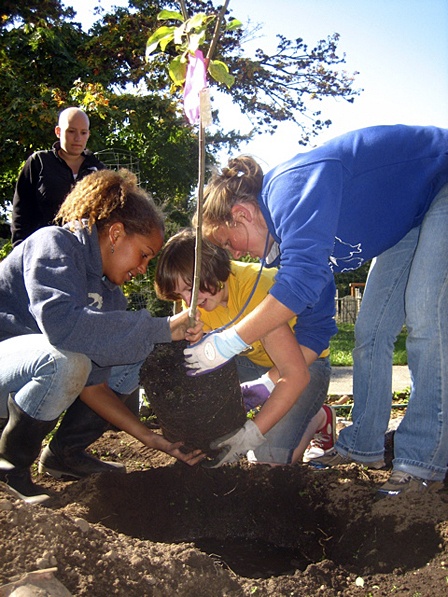What do apples, a contest and some ambitious high school kids have in common?
They all came together to make an orchard for the public school.
With just $90 raised by a bake sale, the Orcas High School Environmental Club was able to rid an area next to the elementary school building of noxious bindweed (of the morning glory family) that was choking all that was previously planted there, and introduced healthy apple trees and grape vines.
This all came about when the Environmental Club was looking for a project that would benefit the school in a positive, Earth-friendly way. At the same time, they were made aware of a contest being conducted by the Student Conservation Association called “Green Your School,” which dovetailed perfectly with conversations they had with the Farm-to-Cafeteria Committee desiring an orchard on the campus.
“This was not a new idea, and had been discussed before,” Environmental Club president Iris Parker Pavitt said, “however, no one really thought it would actually happen.”
It all started coming together. Buzz, the school maintenance man, began by helping them dig up and get rid of the bindweed – a monumental job. The club held a fruit-based bake sale to raise the funds, then visited a local nursery having a sale and purchased one Sweet Sixteen apple, one Sunset apple, one tree with a variety of apple types grafted onto it, one Venus grape vine and one Interlaken grape vine. “
We wanted fruit that was good for eating fresh and didn’t need processing,” says Parker Pavitt. Fencing and stakes were donated, which helped greatly in keeping costs down. Finally, on Oct. 3, a sunny autumn day, members of the Environmental Club, parents and community volunteers gathered to clear the area of remaining bindweed, dig holes, plant, and mulch. The plants are watered every day by members of the Environmental Club during this stage in their young lives, and regular maintenance is scheduled by the Environmental Club and the high school biology class to keep weeds down and oversee the area.
The legacy of the trees the Environmental Club has left the school is summed up by Parker Pavitt in her summation for the contest: “The fruits are to be enjoyed as a healthy, local, and organic food source easily accessible to students, faculty, and visitors. The trees provide shade as well as an aesthetically pleasing view from several classroom windows. Fruit trees help to teach us the lessons of life and to reveal the Earth that supports us all on a very accessible level. Fruit trees can always play a part in our education, whether in areas of agriculture, math, science, art, nutrition, and essentially all other fields of study. Having well-established trees in an environment can greatly assist in the relief of stress and enhance feelings of calm and inner peace. A school campus is the perfect place to institute such venerable and majestic companions as trees.”
“We don’t know yet if they won a prize,” Farm-to-Cafeteria Committee chair Madie Murray said, “but our school and community certainly has, and we have the wonderful efforts of the Environmental Club to thank for it.”




